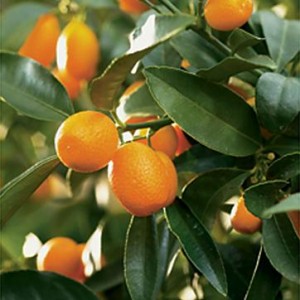Ant-infested Kumquat Tree
 Question from Barbara:
Question from Barbara:
I have a kumquat bush that is in a huge planter. It is three years old. Last year we had 20-30 fruits. This year the bush is FULL of blooms and I am hoping to have a bumper crop. My problem is ants. I have read that it is an indication of aphids. I don’t see any, and unfortunately being a grower of African Violets, I am familiar with the stinkers. I don’t want to disrupt the blooms and loose the crop, but I really don’t want to loose the bush. I would like to keep it as safe as possible, and am willing to mix or make my own if necessary. Please help! Thanks, I really appreciate your time.
Answer from Pat:
You are correct to say that an ant-infected plant will most likely fall prey to aphids, and it might also fall prey to other pests such as scale or any plant-sucking insect. Ants carry pests, such as aphids and scale, from plant to plant in order to “farm” the pests, like putting cows out to pasture. They milk the aphids especially (but also scale and other pests) for their sugary honeydew. Meanwhile the aphids suck the juices from the plant. I am glad you haven’t as yet noticed any aphids, but you are also right to think it’s time to take steps to get rid of the ants now before harm is done.
My own personal experience is that you can get rid of ants and cut them off at the pass, stopping them from climbing up the trunk of a citrus tree and thus onto the leaves, simply by placing a 1 or 2-inch thick layer of dry bagged earthworm castings on top of the soil under the plant. This is a fully organic control and will do nothing to harm the flowers or fruit. (Also prune off the tip of any branch that brushes the ground or touches a wall or any other plant because this could provide an alternate pathway for the ants to get onto the plant without crossing the earthworm castings surrounding the trunk. A layer of earthworm castings on top of the soil does seem to kill or otherwise get rid of the ants, but you may need to wait a week or two for the process to fully take effect. There is a scientific reason why it works. Dry bagged earthworm castings contain an enzyme called “chitinase” (pronounced kite’-en-ase.) This enzyme destroys chitin and chitin is what the exoskeletons of ants and other insects are made of. “Worm Gold” earthworm castings seem to work particularly well at this, but any dry bagged earthworm castings should do the job. It may take two weeks or so before you see the results. Continue to water the tree on your regular schedule. This will not destroy the effect. The earthworm castings will eventually become part of the ground and the tree will take in extra chitinase through its roots which will help it repel ants and other pests over a longer period.
If the soil is loose and friable inside the large planter in which your kumquat is growing,it is possible also that the ants are living inside the container. If this is the case, the earthworm castings should get rid of them without poisons. Be sure to fertilize the kumquat, if you have not already done so, with a fertilizer recommended for citrus. The correct way is to begin feeding citrus in late January and feed throughout warm weather. Citrus trees are gluttons for fertilizer, but be sure to follow package directions in regard to amounts. A well-fed tree can fight off pests and will give you a larger harvest of fruit.
Another and mechanical way to rid a citrus tree of ants is to fix a ring of paper around the trunk of the tree and smear it with a product call “Tree Tanglefoot”. Ants will not be able to cross this very sticky stuff, but this method is less permanent than the earthworm castings and it can be a messy job.
On another subject, I trust there are plenty of bees visiting the flowers on your kumquat tree. If no bees, you will have no fruit. So if you see no bees visiting the flowers, or only a few, be sure to hand pollinate the flowers by going from flower to flower with an artists sable paint brush to spread the pollen. Then you will have a lot more fruit than you had last year.


Thank you so very much for your advise. I will be getting the earthworm castings as soon as I can find a place open that has them. There seems to be a good amount of bees doing the job of pollination, but I may do the brush technique to be sure. I love kumquats, and hope to have enough to put some jam up this year. If all my garden pays off like it looks like it will, I am going to be a very busy person come harvest time. Thanks for all your help and especially your quick response. Have a great week, and happy gardening!
All good news! If there are bees there’s no need for you to hand pollinate the flowers. In fact, much better not to do so. Save your time for other pursuits and leave the flowers and the pollen for the bees. Hand pollination should only be done when there are no bees in attendance. When they are there, let them do their job without interference.